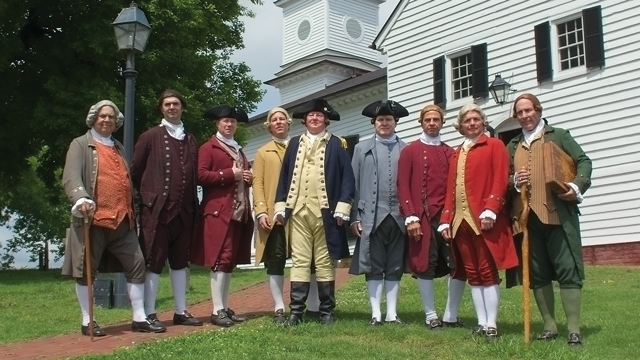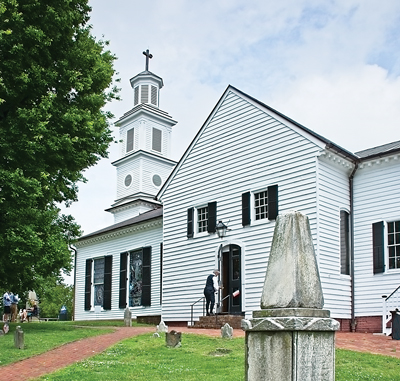Enter to win a family field trip to Historic St. John’s church here.
The reoccurring thought – Get it right! – floods through actor Charles Wissinger’s mind every time he steps into the sanctuary of historic St. John’s Church. As Patrick Henry, he regularly reels off the delegate’s impassioned “Give me liberty or give me death!” speech, delivered during the Second Virginia Convention of March 1775.
St. John’s Church Foundation has been presenting historical reenactments of the Convention at its original location since 1976. Actors in period attire portray nine delegates, including Patrick Henry, Thomas Jefferson, and George Washington.
Wissinger, who also serves as the casting director for the reenactment, feels a heightened sense of responsibility to the guests filling the original high-back pews in the circa-1741 church who have gathered to witness this moment in history.
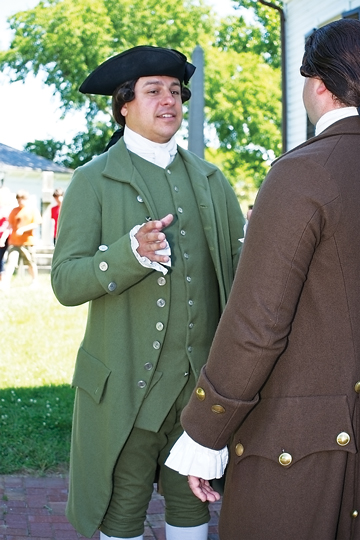
“I try my best to get every single one of the words Henry spoke correct so I am not abbreviating, improvising, or altering the words that are written down. I feel that’s the most important part,” he says, adding that it’s also crucial to understand the emotion and reflection that went into Henry’s delivery of the speech.
Henry’s stirring appeal for freedom and liberty is one of the most famous speeches ever delivered. “Children all around the world memorize his speech, so you really want to get it right when you are saying it because the kids in the audience are reciting it with you,” Wissinger says. “That’s a great feeling when they do that, but it can be scary because you are hoping you are saying it exactly the way it’s written down.”
The Speech, the Delegates, and the Moment
Born in Hanover County, Patrick Henry was one of the great orators of the Colonies going into the American Revolution. His “Give me liberty or give me death!” speech supported his resolution to defend Virginia against the British. No one actually wrote down the words Henry spoke at the Convention, but the account of what happened that day was written about twenty-five years later by Henry’s grandson, William Wirt, who had collected and researched materials for Henry’s biography. During his research, he compiled recollections of men, like Thomas Jefferson, who were in attendance when Henry delivered the powerful speech that went on to serve as a catalyst for Virginia – and the other colonies that would become a new country – to go to war for independence.
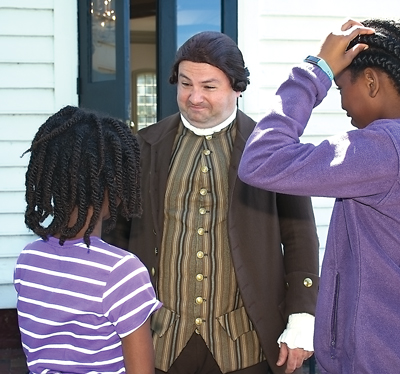
Henry’s speech and argument is a “pretty well laid out legal argument,” says lawyer and part-time actor Christopher Dunn, who plays different roles in the reenactment. “He does it like a closing summation in a jury trial.”
Dunn, who has been acting in the community since the 1970s, began performing at St. John’s about fifteen years ago. He most often portrays Robert Carter Nicholas, the treasurer of the Virginia colony during that time period and the narrator of the performance, as well as Delegate Edmund Pendleton from Caroline County who is
a loyalist like Nicholas.
“Pendleton is not ready to vote for Henry’s resolution,” Dunn says. “His speech is probably the best one, other than Patrick Henry’s. His is the most passionate against the resolution. His speech is well-written and laid out very well.”
During the performance, Henry and Pendleton are the only delegates who leave their pew and walk through the aisles during the performance. “They have free reign to walk and talk to people,” Dunn says.
Through the debates, audience members get to hear and see both sides of the argument “and the sides are pretty well-balanced,” Dunn says. “The audience can leave with a good foundation of
the issues that would have stopped someone from voting for
the resolution.”
Dunn takes it as a self-challenge to see if he can persuade a handful of people in the audience to vote with Pendleton and the other loyalists. At the end of the show, the president of the Convention calls for a vote, and the audience votes by pounding on the pews and cheering “Hear, hear!” along with the delegates. “We want them to be involved,” he says. “Usually everyone votes for Henry’s resolution except for the actors who portray the other side. As an actor, I want to be persuasive enough to make some audience members vote no.”
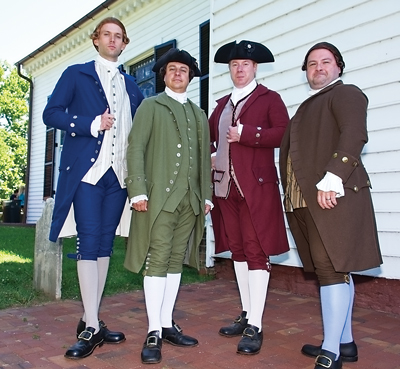
There is one performance that does meet Dunn’s goal. For the last couple of years, the Foundation has held a private show for a British automaker. “On that day, we get a lot of no votes,” Dunn says.
The Performance
Wissinger has been working with the reenactment for fourteen years, and moved into the role of casting director two years ago. “I don’t hire and fire like a regular theatre company. The St. John’s Church Foundation takes care of that,” he says. “I take the existing group of people and cast the shows as they come up.”
A seasoned actor, Wissinger has worked on stage and in films, television, and commercials. He also does interpretations of historical figures from the Revolutionary War, the War of 1812, the Civil War, and World War II. In addition, he currently researches and sews historical clothing for the Foundation, as well as LionHeart Filmworks and The Berkeley Plantation Thanksgiving Festival.
He knows and can play eight of the nine parts in the reenactment. As casting director, he tries to “rotate the actors so they are not doing the same part over and over again,” he says. “For example, we rotate the role of Patrick Henry. We have five actors who can play that part.”
St. John’s offers both public and private shows, educating audiences through entertainment. Annually, the reenactments have attracted around 40,000 visitors, including 5,000 visitors for the summer reenactments. Many of the shows are performed for school groups and other organizations such as the Daughters of the American Revolution. “There are a lot of people who have made this show a tradition,” Wissinger says. “We have one school group that comes from California each year for its annual trip.”
Public shows, held every Sunday from Memorial Day to Labor Day, are frequented by people from around the world. “Patrick Henry is internationally known,” says Amy Swartz, preservation and programs director for the Foundation. “His message about freedom and liberty is timeless. We have lots of people who have friends and family come in, and they bring them to see it.”
Although actors are compensated for their work and are considered part-time staff, for some of them, performing is more like a hobby because of their love of history. “I understand that two-thirds of our guys have a professional career that doesn’t involve acting. I have the difficult task of working with everyone’s availability and schedule,” says Wissinger. “When I cast, I look at availability and who knows what parts.”
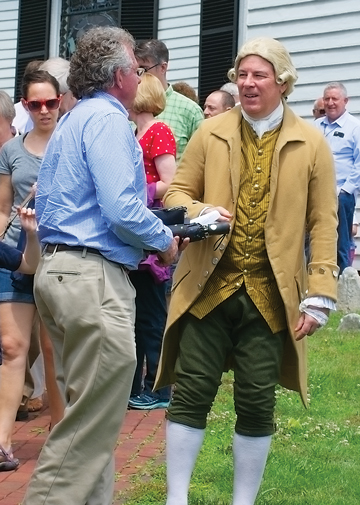
Wissinger also makes and maintains the costumes for the production. “When I joined St. John’s Church Foundation, the only costume that fit me was old and dry-rotted,” he says. “I took it upon myself to make my own costume. I was asked by the Foundation to make costumes and replace the ones that were going bad.”
Costumes are made to fit a person’s body type. “We are required to have the actors try on someone else’s outfit if that person is not working that day to see if they can wear it as well,” he says. “We probably have a good fifteen to twenty complete outfits.”
The Actors
Actor Steve Hawkins is celebrating his sixteenth year with the production. A school equipment salesman and part-time actor, he currently plays Peyton Randolph, president of the Convention, as well as Colonel George Washington, and plantation owner Benjamin Harrison, the first role he performed with the show.
He remembers an incident that occurred that first year. “I was playing Harrison, and I got a little too animated and my wig flew off,” he says, “and a woman sitting next to me gasped. I picked up my wig, put it back on my head, smiled and said, ‘Now, you have seen someone flip their wig.’”
Hawkins, who has appeared in the PBS/WCVE documentary, Liberty or Death, playing the role of Benjamin Harrison, also works with the Parson’s Cause Production in Hanover Country as Sheriff Tompkins. He enjoys portraying history and believes it must be done “with realism as well as enthusiasm to capture the audience’s attention,” he says. “Everyone must give 100 percent effort to make it a successful performance.”
To Hawkins, it is a “privilege and an honor to stand in the place where this event actually happened,” he says. “It is very humbling. It’s a wonderful experience.”
For Dunn, it’s the “best acting job in town,” he says. “When we do the public shows, everyone in the church is from all over the world. They want to be there. If I am the narrator that day, I am walking in a space where George Washington walked. To see people get so excited by Patrick Henry’s lines that they rise and applaud – that’s what gives me chills.”
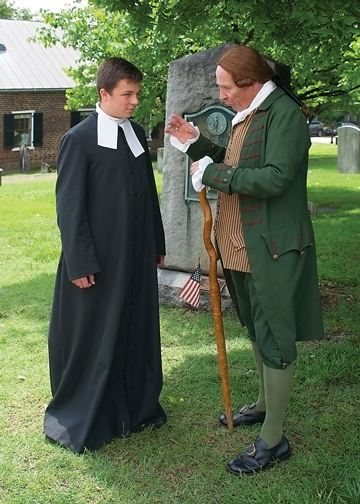
Lucas Hall, who works for Virginia Repertory Theatre and also acts in theatre, film, and television, takes his various roles in the production to heart. “I am a huge history buff and an actor, so this marries my two loves,” says Hall, who started with the reenactment in 2006 with the filming of Liberty or Death. “Having been in the cast this long, we are kind of like an extended family. At this point, it is more than just an acting gig.”
These days, you’ll see Hall portraying Peyton Randolph, Robert Carter Nicholas, Richard Henry Lee, Benjamin Harrison, Thomas Nelson, and once in a while, Thomas Jefferson.
Growing up in Virginia, he has always been interested in history. “Lots of our family vacations were to historical sites in the region,” Hall says.
As preparation for his roles, he recently went to Williamsburg to visit Randolph’s house and Nicholas’s pew at Bruton Parrish Church. He also visited Yorktown to see Nelson’s house and Berkeley Plantation to visit Harrison’s house.
“I also took a special trip to Philadelphia a couple years ago to see Carpenters’ Hall, the site of the First Continental Congress where Randolph was our first president,” he says. “I went to lots of other places in Philadelphia, but what I really wanted to see was Carpenters’ Hall.”
The reenactment at St. John’s is an important reminder of the birth of a country. “We must never forget our roots as a nation and the sacrifices that people made for this great country,” says Hawkins. “Some of the most enthusiastic people who come to see the reenactment come from the West Coast, areas such as California and Washington. There is no Colonial history in the western states and they are enthralled with what they see here in Virginia.”
He finds that people are often surprised to learn that George Washington fought for eight years in the Revolution, or that Thomas Nelson was a successful merchant before the war and became destitute after the war. “They are also surprised that Benjamin Harrison fought furiously not to go to war, but one year later, he signed the Declaration of Independence.”
Hawkins says being a part of the reenactment and presenting it for families and kids is a great honor for him, summing up the role of living history like this: “Here at St. John’s, this history is brought to life. As long as the reenactments are held, it will never be lost or forgotten.”
The Church
An active Episcopal church, St. John’s Church holds two regular Sunday morning services during the year, except in the summer when it only holds one. The church’s sounding board, which helps project the minister’s voice, is one of the last original architectural features in the church, dating to 1741 when St. John’s was built. It is one of only three Colonial-era sounding boards in Virginia. It hangs above the elevated pulpit, and was in place when Patrick Henry delivered his “Liberty or Death” speech inside the church in 1775. The sounding board has undergone a paint analysis and has been restored to its original appearance.
Visitors to Historic St. John’s Church can relive the excitement of Henry’s speech at this national historic landmark via live reenactments. They can also explore the city’s first public cemetery, the final resting place of many important figures in American history, including George Wythe, who not only signed the Declaration of Independence, but also taught the law to Thomas Jefferson, Chief Justice John Marshall, and Henry Clay. Wythe also signed Patrick Henry’s law license. The mother of Edgar Allan Poe, Elizabeth Arnold Poe, is also buried in the St. John’s Church cemetery.
In 2013, the Legacy of Liberty Preservation Project: Phase 2 was launched. Over the next two years, St. John’s Church Foundation raised a total of $483,000, which allowed the Foundation to replace leaking roofs on the church, the parish hall, and boiler house; paint the church and parish hall exteriors; repair and replace the church shutters; make plumbing repairs; and conduct a structural analysis of the roof and foundation.
At Historic St. John’s Church, the mission is to engage students and adults by placing them in the very setting where our forefathers debated the issues that ultimately led to the founding of the United States. More than 40,000 students and adults from across the country and around the world travel to St. John’s Church annually. Programs include guided tours, reenactments, classroom lessons aligned to Virginia Standards of Learning, free programs for Title I schools, historical exhibitions, and several lectures every year. The gift shop is another highlight for visitors. For details about the weekly reenactment, visit historicstjohnschurch.org.


